Modeling the Responses of Alligator Gar Populations to Harvest under Various Length-Based Regulations: Implications for Conservation and Management
Abstract
Interest in managing Alligator Gar Atractosteus spatula populations as a unique sport fishery has increased over the past decade, but despite this interest population responses to harvest are poorly understood. Fishing regulations for Alligator Gars vary throughout their distribution; however, to date most regulations have focused on a daily creel limit. We developed an age-structured dynamic-pool model in R to (1) quantify the population-level effects of exploitation and (2) evaluate how these effects would be altered under a suite of length-based fishing regulations. The model was parameterized based primarily on empirically estimated dynamic rates for Texas Alligator Gar populations. For each model scenario, we calculated the mean and variance of the number of trophy fish in the population, the population size, the spawning potential ratio, and the fishery yield over a 100-year period. Alligator Gar populations were highly sensitive to exploitation in our model simulations. An exploitation rate of 7% caused the average population size to decline by 50%, and a rate of only 3% halved the number of trophy fish available in the population. Under no length restrictions, recruitment overfishing occurred above an exploitation rate of 6.5%, while yield was maximized at only 9% exploitation. Based on our model results, the use of length limits may provide some options for sustaining existing trophy Alligator Gar fisheries under increased effort and could allow anglers to catch and even harvest more trophy-size fish. Given the sensitivity of long-lived periodic life history strategists to exploitation and the benefits that length-based regulations can provide, we encourage managers to consider such regulations to increase resilience to exploitation and improve fishery quality.
Interest in Alligator Gar Atractosteus spatula conservation, and management of this species as a unique sport fishery, has substantially expanded over the past decade. Population declines and extirpation across much of its native range led to the designation of the Alligator Gar as vulnerable by the American Fisheries Society in 2008 (Jelks et al. 2008). Currently, 10 of the 14 U.S. states that historically had Alligator Gar populations are actively managing populations through harvest regulations and reintroduction programs. In Texas, a statewide one-fish-per-day creel limit for Alligator Gars was imposed by the Texas Parks and Wildlife Department (TPWD) on the previously unregulated fishery in 2009 (Binion et al. 2015; Buckmeier et al. 2016). Following the implementation of this new creel limit, TPWD has conducted a wide range of research on Alligator Gar populations to provide the data necessary for the conservation and management of the species within the state (e.g., Buckmeier et al. 2012, 2013, 2016, 2017; McDonald et al. 2013; Bennett et al. 2015; Binion et al. 2015; Daugherty et al. 2017). Our goal in this study was to integrate this new data into a simulation model to examine the effects of harvest on Alligator Gar populations.
Despite increased interest in managing Alligator Gar fisheries, population responses to harvest are poorly understood (Ferrara 2001). Like sturgeons (family Acipenseridae), the Alligator Gar is a periodic life history strategist, characterized by a long life span, late age at maturity, high fecundity, sporadic recruitment, and large adult body size (Winemiller and Rose 1992). Past investigations have revealed that while these life history adaptations allow species to inhabit dynamic systems and withstand variable recruitment, they also make species susceptible to growth and recruitment overfishing (Ricker 1963; Adams 1980; Francis 1986; Rieman and Beamesderfer 1990; Ferrara 2001). For example, Quist et al. (2002) reported rapid declines in the reproductive potential of Shovelnose Sturgeon Scaphirhynchus platorynchus as exploitation increased from 0% to 20%. Similarly, Boreman (1997) found that fishing mortality as low as 5% resulted in a 50% reduction in lifetime egg production in White Sturgeon Acipenser transmontanus and Atlantic Sturgeon A. oxyrinchus. Because of their similar life history, Alligator Gars are likely also vulnerable to overharvest, but the response of Alligator Gar populations to varying levels of exploitation has not been reported.
Historically, many fishery regulations focused on achieving maximum sustainable yield, as both recreational and commercial fisheries were primarily consumptive (Redmond 1986; Nielsen 1999; Gwinn et al. 2013). However, the consumption motive has declined among current recreational anglers (Arlinghaus et al. 2007; Bonds et al. 2008; Gwinn et al. 2013), replaced by other catch-related factors such as catch rate (Anderson 1993; Cox et al. 2003) and catches of trophy fish (Jacobson 1996; Arlinghaus 2006; Garcia-Asorey et al. 2011; Hutt et al. 2013). Thus, contemporary fishery management objectives are more complex, as managers attempt to satisfy a diverse array of angler desires and expectations (Garcia-Asorey et al. 2011). Trophy angling motivations for Alligator Gars are well known (Scarnecchia 1992; Ferrara 2001; Buckmeier et al. 2013; Binion et al. 2015); however, the ability to harvest Alligator Gars remains an important management consideration. Garcia de Leon et al. (2001) reported that Alligator Gars are a highly valued food fish in Mexico, and commercial fisheries continue to exist in the United States (e.g., Louisiana and Texas). Providing harvest opportunities and high catch rates of trophy-size individuals can be conflicting management objectives. A broader understanding of the effects of various fishing regulations is needed to identify the trade-offs between yield, catch, and trophy potential (Walters and Martell 2004; Garcia-Asorey et al. 2011; Gwinn et al. 2013).
Fishing regulations for Alligator Gars vary throughout their distribution; however, to date most regulations have focused on a daily creel limit. Unfortunately, creel limits can fail to protect against growth and recruitment overfishing (Noble and Jones 1999), as they do not directly control fishing effort (Ross 1997) or the size of fish harvested. As the popularity of recreational Alligator Gar fisheries continues to grow, simple creel-based regulations will likely be ineffective in meeting the desires of anglers or the conservation needs of the species. Alternatively, length-based regulations can be used both to prevent overharvest and sustain trophy fishing opportunities (Wilde 1997; Dotson et al. 2013). Minimum length limits that prevent the harvest of fish below a specified length are most common (Gwinn et al. 2013), but maximum length limits, harvest slots (which permit the harvest of fish between specific minimum and maximum lengths), and protective slots (which protect fish between specific minimum and maximum lengths) have also been used. Arlinghaus et al. (2010) reported that harvest slots increased fishing quality for Northern Pike Esox lucius by increasing the abundance of trophy fish while maintaining the number of smaller, harvestable fish. Garcia-Asorey et al. (2011) reported that minimum size limits were most effective at maintaining steelhead Oncorhynchus mykiss (anadromous Rainbow Trout) abundance, whereas maximum size limits were most effective at preserving large fish. However, none of the life history parameterizations evaluated in these studies adequately represented that of the Alligator Gar. Therefore, we used simulation modeling to (1) quantify the population-level effects of exploitation and (2) evaluate how these effects would be altered under a suite of length-based fishing regulations. Our results illustrate the sensitivity of Alligator Gar populations to overharvest and provide insight as to how length-based regulations could be used in lieu of creel limits or quotas to accomplish management objectives.
Methods
Model description
We developed an age-structured, dynamic-pool model (Quinn and Deriso 1999) in R (version 3.0.1) to model the population-level response to exploitation under various length-based harvest regulations. A hypothetical population of Alligator Gars was created with starting values for the number of fish in each age-class set to represent a population of 10,000 individuals (females) at equilibrium under constant recruitment. This population size was on the same order of magnitude as population estimates for the middle Trinity River (8,000; Buckmeier et al. 2016) and Choke Canyon Reservoir in Texas (5,400; Binion et al. 2015). Population dynamics were simulated for 100-year periods, with 1,000 iterations of each harvest scenario.
The model was parameterized based primarily on empirically estimated dynamic rates for Texas Alligator Gar populations. Natural mortality was estimated from two recent studies of such populations. Longevity of 50 years and total mortality of 8.5% were based on the Alligator Gar life history in the middle Trinity River (Buckmeier et al. 2016). To estimate natural mortality, we subtracted exploitation from total mortality. Exploitation was estimated at 3% based on tag return data in the Trinity River and Choke Canyon Reservoir (Binion et al. 2015; Buckmeier et al. 2016). Thus, natural mortality was 5.5% annually, assuming that fishing mortality was additive rather than compensatory (Allen et al. 1998; Rose et al. 2001; Winemiller 2005).



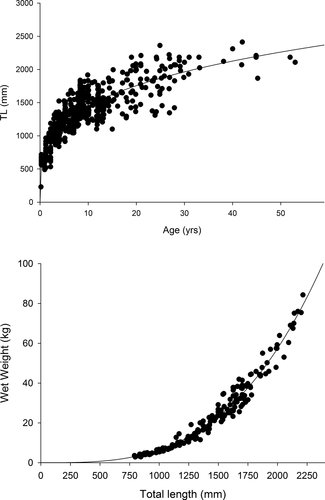

Scenarios and data outputs
We explored several exploitation scenarios. While total exploitation could include multiple user groups (including rod-and-reel anglers, bowfishers, and commercial fishers), we did not distinguish among groups, modeling only their combined harvest. As a baseline measure, we first looked at a simple, fixed exploitation rate across all ages and sizes of fish. Although the data are limited, Bennett and Bonds (2012) reported no apparent size-selective exploitation of Alligator Gars, with harvested fish ranging from 229 to 2,210 mm TL. Next, we evaluated several length-based harvest restrictions, modeling population responses to minimum length limits of 1,219, 1,524, and 1,828 mm TL, with harvest below the length limit being set to zero. We then used these same total lengths as maximum length limits, with the harvest of fish above the length limit being eliminated. Finally, we examined a 1,219–1,828-mm protected slot, through which the harvest of smaller and larger fish was permitted but that of fish within the slot was set to zero.
For each model scenario, we calculated the mean and variance of the number of trophy fish in the population (i.e., fish ≥1,828 mm; Binion et al. 2015), the population size, the spawning potential ratio (SPR), and the fishery yield over the 100-year simulation period. Critical reference values for each response variable were predetermined to identify exploitation thresholds. For the number of trophy fish and population size, the critical reference values were 50% of those under unfished conditions. Following Goodyear (1993), we used a somewhat conservative critical value of 30% for SPR. Finally, the critical reference value for fishery yield was the maximum sustainable yield (MSY).
Because the trophy fishery aspect of Alligator Gar fisheries is important in Texas and a common goal for management, we concentrated our analyses of length-based regulations on their impact on trophy potential. Because the benefit of length-based regulations varies depending on the exploitation rate, we held exploitation constant at 5% to compare the relative improvements provided by the various options. For population size, SPR, and yield, we evaluated how the various length limits influenced the baseline exploitation rate required to reach the critical reference values (i.e., 50% of the unfished population size, 30% SPR, and MSY).
Results
Alligator Gar populations were highly sensitive to exploitation in our model simulations. The mean population size over the 100-year period declined quickly with increasing exploitation, reaching 50% of that under unfished conditions at an annual exploitation rate of about 7% (Figure 2). Estimates of the mean SPR declined at a similar rate, falling below the critical level of 30% at about 6.5% exploitation. The mean number of trophy fish in the population declined more rapidly, with only 3% exploitation being required to halve the mean number of such fish available. The mean MSY occurred at about 9% exploitation.
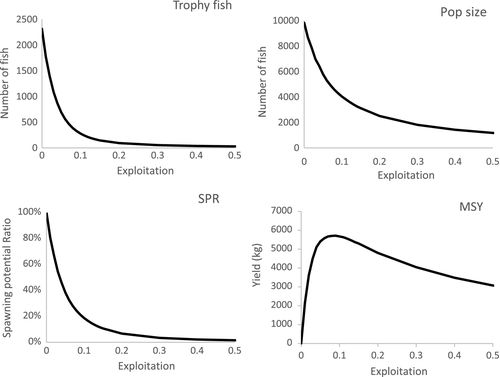
As one would expect, limiting harvest based on size resulted in an increase in the number of trophy-size fish available in the population (Figure 3A). At the baseline level of 5% exploitation, minimum length limits of 1,219, 1,524, and 1,828 mm resulted in increases of 20%, 56%, and 125%, respectively, in the average number of trophy-size fish in the population. Maximum length limits led to increases of 171%, 107%, and 40%, respectively, and the 1,219–1,828-mm protected slot led to an 84% increase in the mean number of trophy-size fish. The variability in the number of trophy fish in the population was largely unaffected by the minimum or slot length limits, but variances were substantially higher under the three maximum length limit scenarios (Figure 3B).
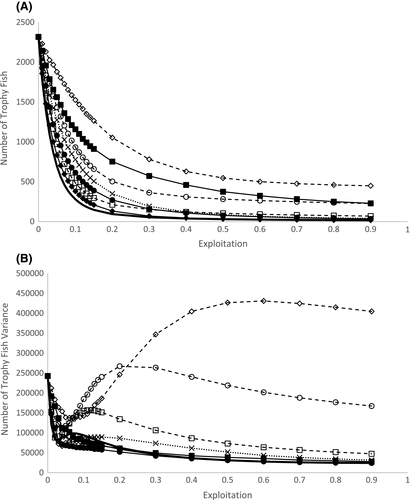
The underlying exploitation rates required to reduce the mean population size to 50% of that under unfished conditions increased under the various length-based protections compared with the baseline of 7% and no length limits (Figure 4A). For minimum length limits of 1,219 mm and 1,524 mm, exploitation rates of 14% and 42%, respectively, were required to halve the mean population size. Under a 1,828-mm minimum, the mean population size was not reduced to 50% under any exploitation rate. The maximum length limits moderately increased the exploitation rates needed to halve the population—to 18%, 11%, and 8%, respectively, for 1,219, 1,524, and 1,828 mm. Finally, the protected slot resulted in an exploitation rate of 14% being needed to reduce the mean population size to below 50%. Variance increased substantially under the minimum length limits, while the maximum and slot limits had little effect on variability compared with no length restrictions (Figure 4B).
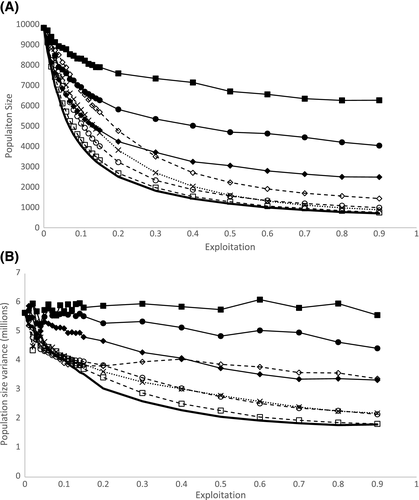
Length-based restrictions also increased the exploitation rates required to reduce SPR to below 30% from a baseline of 6.5% under no length restrictions to about 85% under the most restrictive scenario (Figure 5A). Minimum length limits resulted in breakpoints of 9%, 17%, and 85% exploitation rates being required to reduce SPR to below 30% under 1,219-, 1,524-, and 1,828-mm minimums. The respective maximum length restrictions resulted in exploitation rates of 30%, 14%, and 8.5% being needed to reduce SPR to below the 30% critical value. With the protected slot, an exploitation rate of 15% was needed to reduce SPR to below 30%. Below an exploitation rate of 10%, length-based regulations had little influence on variability (Figure 5B). Under higher exploitation rates, the 1,219-mm and 1,524-mm maximum length limits led to considerably higher variances in SPR.
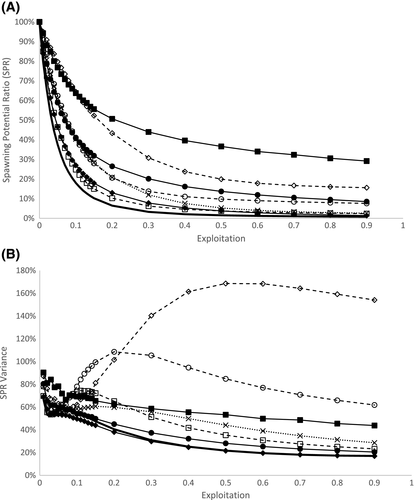
In all cases, length-based harvest restrictions increased the exploitation level required to maximize yield (Figure 6A). In addition, all three minimum length models led to increases in the actual yield attained at MSY. The maximum length limits reduced the actual yields attained, while the slot limit had a mixed effect, reducing yields at exploitation rates less than ~17% and raising them slightly at higher exploitation rates. The exploitation rates required to maximize yield under the 1,219-, 1,524-, and 1,828-mm minimum length limits were 13%, 20%, and 40%, respectively. With maximum length limits, the exploitation rates that maximized yield were 30%, 15%, and 12%, respectively. Yield under the protected slot was maximized at an exploitation rate of 14%. The variation in yield was substantially reduced under all of the length-based regulations relative to the base model (Figure 6B).

Discussion
We found that Alligator Gar populations were vulnerable to levels of exploitation that would be considered low for most other recreational fisheries. These results reflect the natural longevity of this species. An exploitation rate of only 7% caused the average population size to decline by 50%, and yield was maximized at only 9% while greater levels of exploitation resulted in growth overfishing. In a review of the impacts of recreational angling, Lewin et al. (2006) found an upper range of exploitation rates from 40% to 80% for common recreational freshwater fisheries (e.g., White Bass Morone chrysops, Largemouth Bass Micropterus salmoides, crappies Pomoxis spp., Yellow Perch Perca flavescens, and Rainbow Trout). Although studies have been limited for long-lived fishes with periodic life history strategies, these species tend to be highly sensitive to exploitation. As in our model for Alligator Gar, Quist et al. (2002) found potential for growth overfishing at exploitation rates of 10% or less in Shovelnose Sturgeon and Rieman and Beamesderfer (1990) reported likely growth overfishing at exploitation rates exceeding 3–6% for White Sturgeon in the absence of length limits.
The risk of recruitment overfishing has also been documented or modeled for long-lived fishes under comparatively low exploitation rates in the absence of length limits. For example, Quist et al. (2002) found that an exploitation rate of 10% reduced the SPR of Missouri River Shovelnose Sturgeon to below 30%, indicating the potential for recruitment overfishing. Similarly, Boreman (1997) found that the SPRs for White Sturgeon, Atlantic Sturgeon, and Shortnose Sturgeon A. brevirostrum fell below 30% under additional morality rates of 4%, 5%, and 9%, respectively. Additionally, while not referencing SPR specifically, Rieman and Beamesderfer (1990) found that in models of White Sturgeon harvested under no length restrictions the fishery collapsed at an exploitation rate of 10%. These estimates are similar to our estimate of 6.5% for Alligator Gars and are likely primarily driven by the longevity of the group. We calculated and report SPR for Alligator Gars as a measure of the potential for recruitment overfishing even though our model did not include density-dependent recruitment but rather was based on environmental drivers of recruitment. Although we are confident that at current populations densities in Texas recruitment is primarily driven by the availability of spawning habitat associated with the timing and duration of flood events (Buckmeier et al. 2017), it is likely that if adult populations are sufficiently depressed, a spawner–recruit relation will also be evident. Therefore, a low SPR value serves as a warning sign that recruitment could become tied to spawner density in addition to environmental conditions.
These findings indicate that without length regulations, long-lived fishes such as Alligator Gars and sturgeons risk recruitment overfishing at or before MSY is achieved. Fortunately, for Texas Alligator Gar populations MSY is not a management objective. We found that the size structure of our simulated Alligator Gar populations was impacted at even lower levels of exploitation; a rate of only 3% halved the mean number of trophy fish available. Binion et al. (2015) and Buckmeier et al. (2016) recently reported that the current exploitation rate in Texas is about 3%, indicating that the size structure of these populations has probably been somewhat truncated already. Based on our model results, increasing interest in Alligator Gar fisheries in Texas may further threaten the size structure of remaining trophy populations because at an exploitation rate of 7% the number of trophy fish available was reduced to only 20% of the number under unfished conditions. Additionally, at this level of exploitation the overall population size will be cut in half and SPR will fall below our critical value. If increased effort leads to increased exploitation, alternative regulation options will need to be considered to continue providing unique trophy fishing opportunities for Alligator Gars.
Based on our model results, the use of length limits may provide some options for sustaining existing trophy Alligator Gar fisheries under a scenario of increased effort and could allow anglers to catch and even harvest more trophy-size fish. Among the regulations examined, four had the most potential to increase the number of trophy fish while being acceptable to current Alligator Gar anglers. These included two minimum length limits (1,524 mm and 1,828 mm), the 1,524-mm maximum length limit, and the 1,219–1,828-mm protected slot. We recognize that the 1,524-mm maximum length limit would likely be unacceptable to anglers unless they were allowed to harvest a set number of fish over the maximum per season. A similar regulation is currently used to manage the Red Drum Sciaenops ocellatus fishery in Texas, by which one fish above the harvest slot length limit of 508–711 mm is allowed per year using a tag that comes with the angler's license (TPWD 2016). This one-over-the-maximum size limit would result in fewer trophy-size fish being available in the population. We considered the 1,219-mm maximum length limit to be unacceptable to anglers because it is too restrictive for a fish that is capable of reaching lengths of more than double that size. The 1,219-mm minimum and the 1,828-mm maximum length limits are also excluded because they provide small benefits in terms of the mean number of trophy-size fish available relative to the other regulations.
The two minimum length limit options (1,524 mm and 1,828 mm) provide substantial protection to population size and SPR while increasing the number of potential trophy-size fish available to anglers. Between the two options, the 1,828-mm minimum length limit provides the most trophy fish and the least reduction in population size and SPR, although the 1,524-mm minimum provides somewhat more yield. If management goals are dominated by maximizing trophy fishing opportunities, minimum length limits in general—and the 1,828-mm limit in particular—are likely the best option. If, on the other hand, managers want to provide for some harvest of smaller individuals for consumption-oriented anglers, these strict minimums are less desirable.
As compromise regulations, the 1,524-mm maximum length limit and the 1,219–1,828-mm protected slot limit allow harvest of a broader range of fish while increasing trophy potential. While the 1,524-mm maximum length limit as modeled provided greater benefits than the protected slot limit, considering there would likely need to be some allowable harvest over this maximum to make it acceptable to anglers, the two regulations would probably function quite similarly in practice. Compared with the two minimum length limits, the 1,524-mm maximum and the protected slot regulations were intermediate in terms of trophy potential. These regulations lead to smaller gains in population size than either of the minimum length limits and function similarly to the 1,524-mm minimum length limit in terms of improvements to SPR compared to the model with no length restrictions.
Given the sensitivity of long-lived periodic life history strategists to exploitation and the benefits that length-based regulations can provide, we encourage managers to consider such regulations to increase resilience to exploitation and improve fishery quality. We recognize that these more complicated regulations may be perceived negatively by anglers, so presenting trade-offs from which anglers can choose is important. For Alligator Gars, length-based harvest restrictions could maintain population viability without limiting access as angling effort increases. All of the length-based regulations modeled improved the SPR, and among the best four trophy regulations discussed all at least doubled the exploitation rate required to reduce it to 30%. This is particularly important given that even some of Texas' best fisheries are only comprised of several thousand adults, allowing harvest of only a few hundred fish annually (Binion et al. 2015; Buckmeier et al. 2016). Our modeling results indicate that length-based harvest regulations can serve as a viable alternative to harvest quotas or limited entry as a means of addressing conservation concerns while maintaining recreational fisheries.
Acknowledgments
We would like to thank the many staff of the Texas Parks and Wildlife Department who helped collect Alligator Gars in Texas and who provided the data used in our modeling effort. Funding was provided, in part, by the U.S. Fish and Wildlife Service through Federal Aid in Sport Fish Restoration grants F-30-R, F-231-R1, F-231-R2, and F-221-M. There is no conflict of interest declared in this article.




